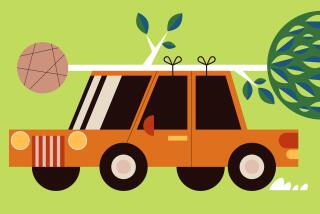Audubon’s Gift to L.A. Kids
- Share via
You there, racing up the Pasadena Freeway past Highland Park: Look up. See that red-tailed hawk circling high? The Western tanager flitting between the sycamores? Follow them off Avenue 43 and up the hill to Ernest E. Debs Regional Park. Get out of your car. The dried grass on the hillsides, sun-baked for months, crunches underfoot and the dry heat bears down.
But once you’re through the black iron gates embellished with hummingbirds and butterflies, the bustling natural world comes into focus. A dragonfly skims the surface of a meandering creek. Coyotes tramp down from the hills to drink and cottontail rabbits hop through the brush.
After a year of construction, the 17-acre Audubon Center at Debs Park opens next week. The center, Audubon’s first in California and only its second nationwide, is devoted to nature education for all ages. Youngsters can touch Fluffy, a domesticated gopher snake, as she curls around her keeper. Older kids and adults can hike, learn about the 138 bird species in the park and participate in the center’s work of restoring and maintaining native trees and plants. Admission is free, as are many of the guided hikes and stargazing and craft workshops planned for the coming months.
Founded in 1905, the Audubon Society long ago shed its fusty image of corduroy-and-tweed birdwatchers and aims now for a nationwide string of urban nature centers. The group believes that only by encountering the natural world as children will adults come to appreciate it and help preserve it.
The city-owned Debs Park couldn’t be a better spot to make that point: Fifty thousand children live within two miles, many of them part of poor working families along the city’s gritty industrial edge. The park itself has long been an underused jewel -- 282 acres of hillside trails just 10 minutes from downtown Los Angeles.
The $4.8-million Audubon project was financed with public and private money. Anchoring the 17 acres that Audubon manages along Debs Park’s western side is the center’s headquarters building, a sustainable marvel. It operates without city electricity; solar energy powers all the computers, lights and air conditioning. Cinder-block walls are insulated with fly ash, a coal mining byproduct; countertops are surfaced with crushed sunflower shells embedded in resin.
Amid the soaring birds and the oaks, visitors can’t help but feel serenely isolated. But the Audubon Center is more accurately another link, along with the planned Cornfield and Taylor Yards parks, in a lengthening green chain bringing the flutter of wings, the rustle of leaves and broad swaths of grass to the urban heart of Los Angeles.
More to Read
Sign up for The Wild
We’ll help you find the best places to hike, bike and run, as well as the perfect silent spots for meditation and yoga.
You may occasionally receive promotional content from the Los Angeles Times.






